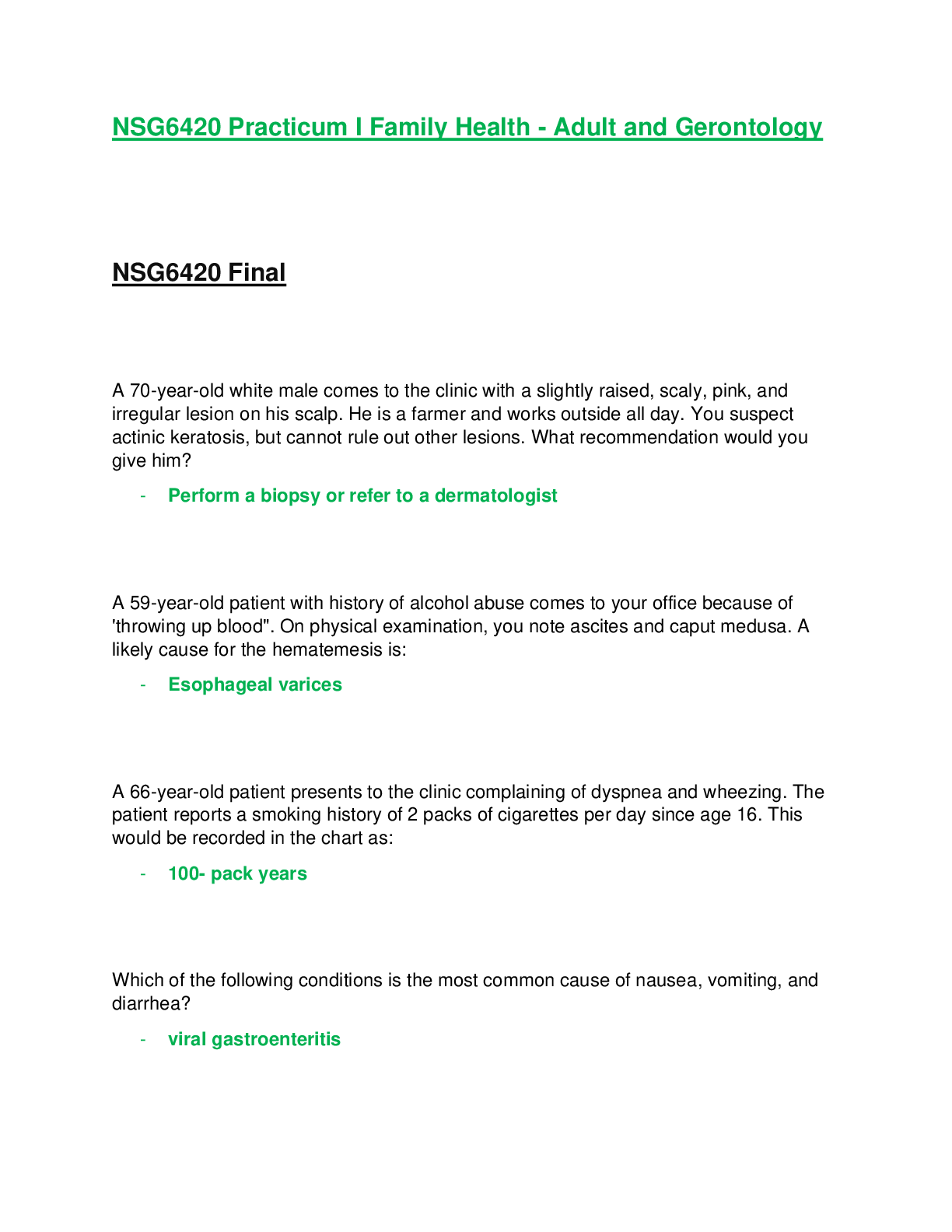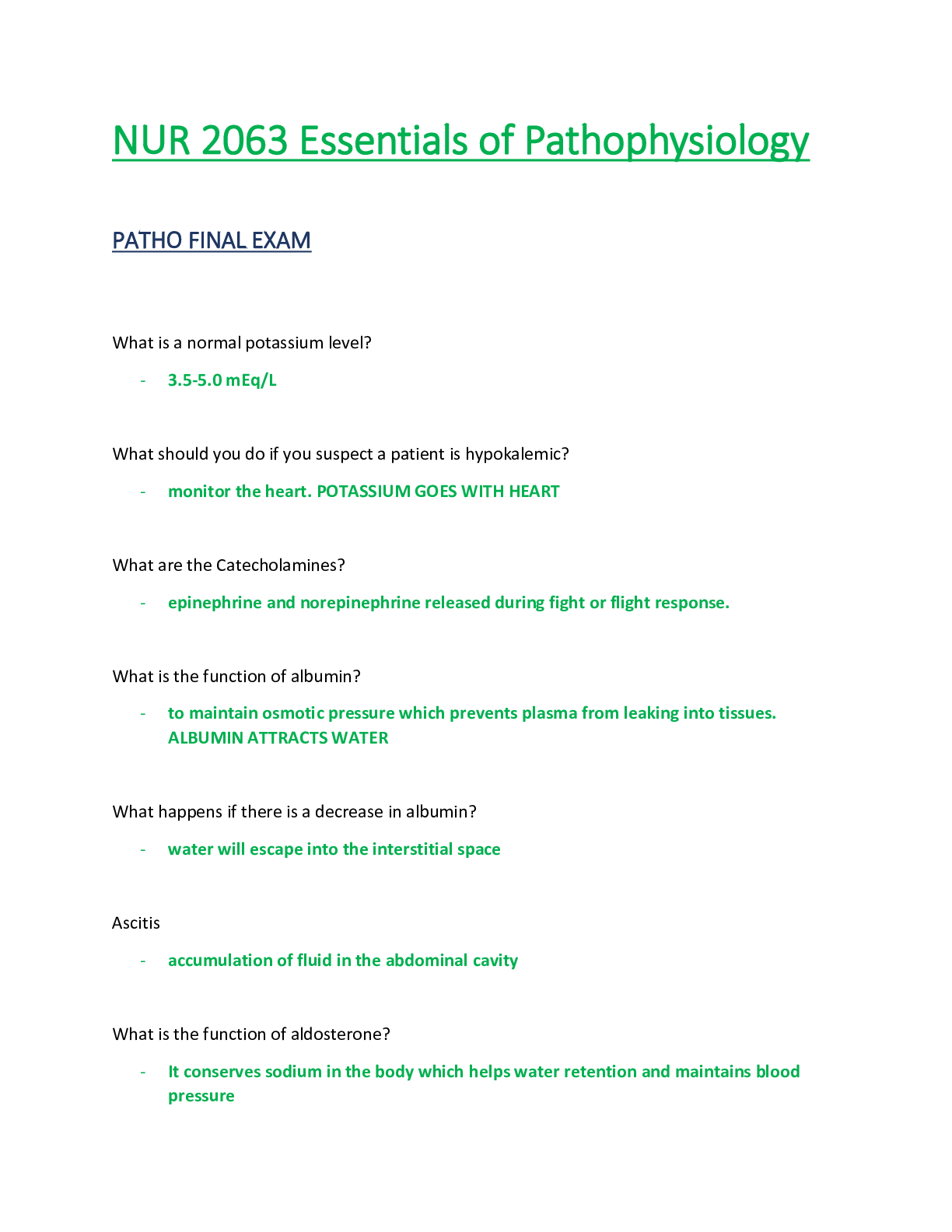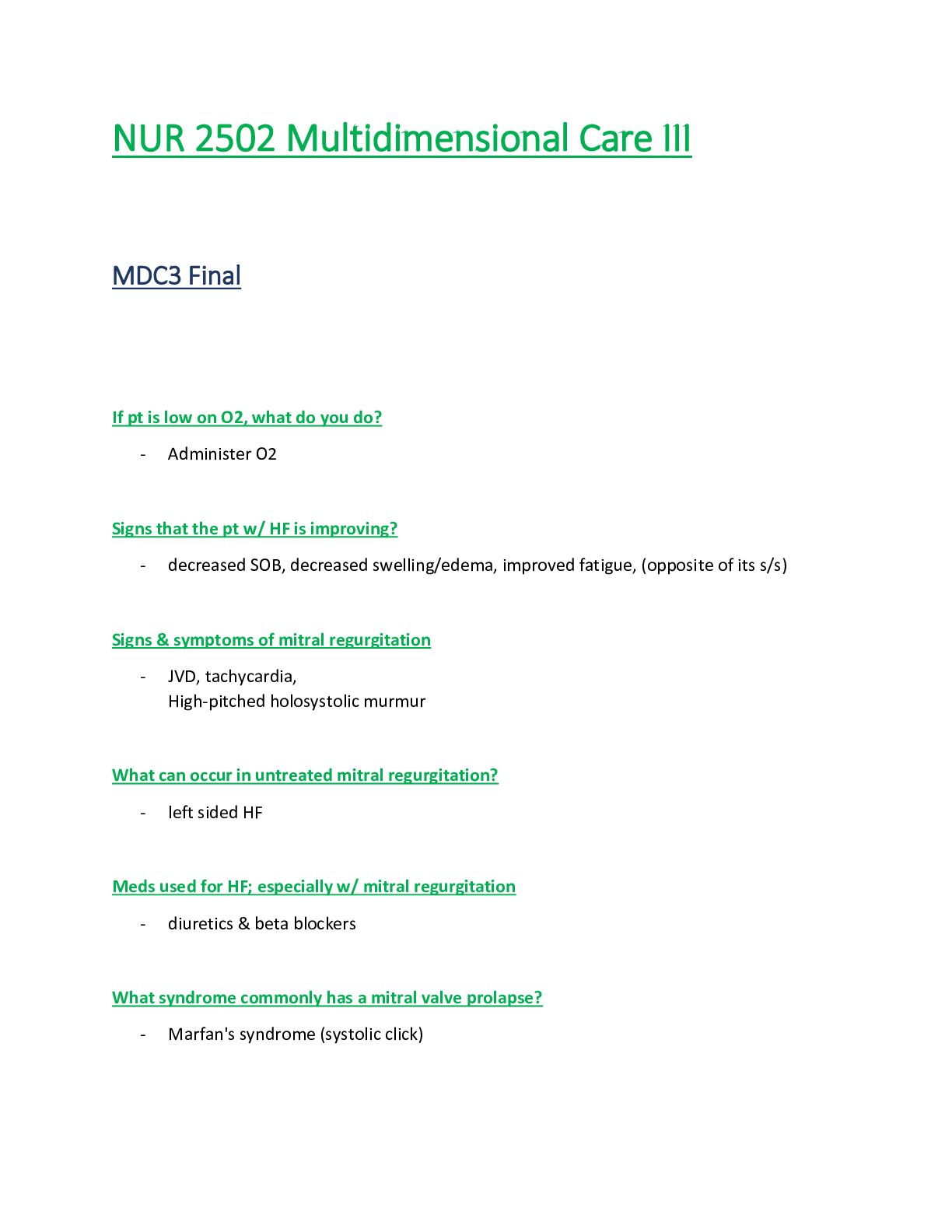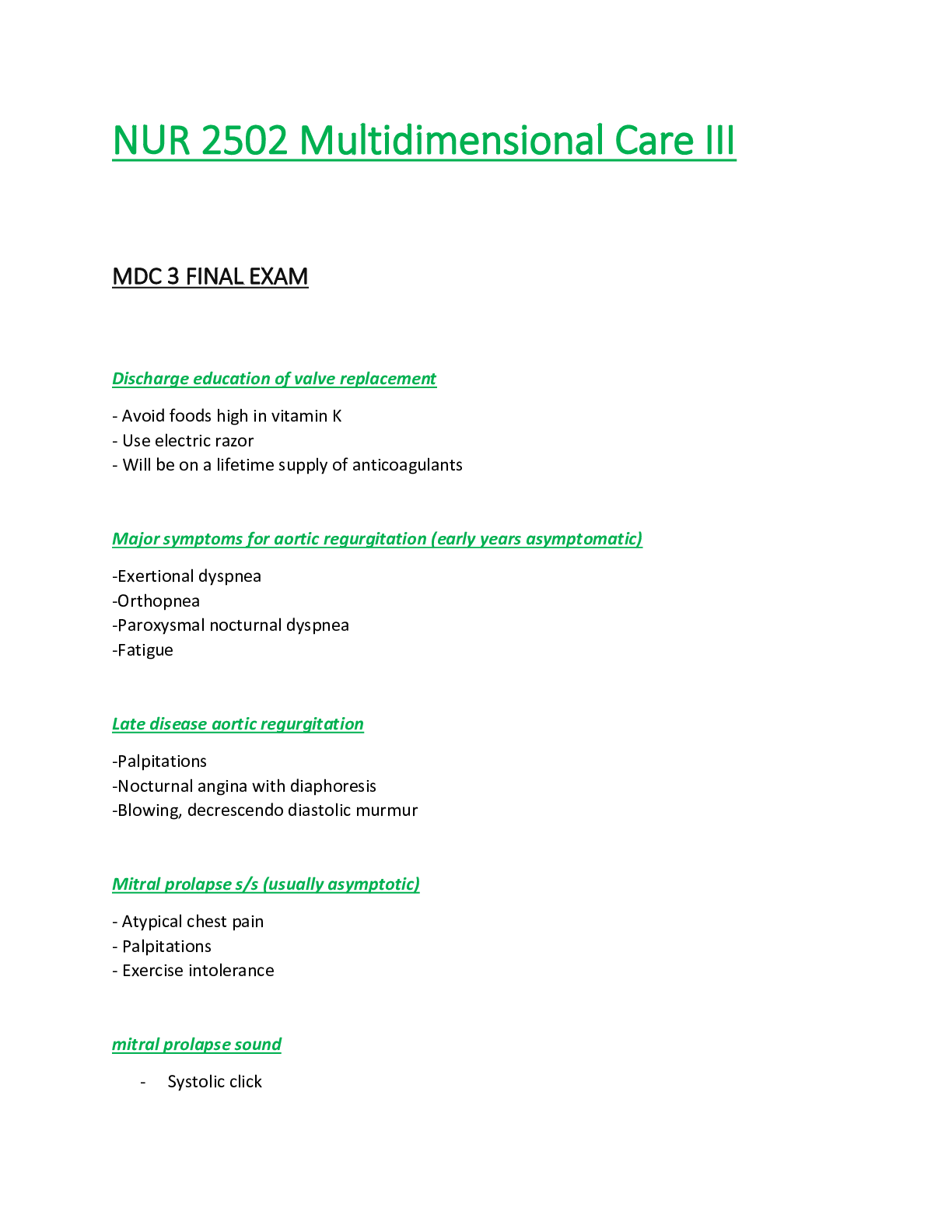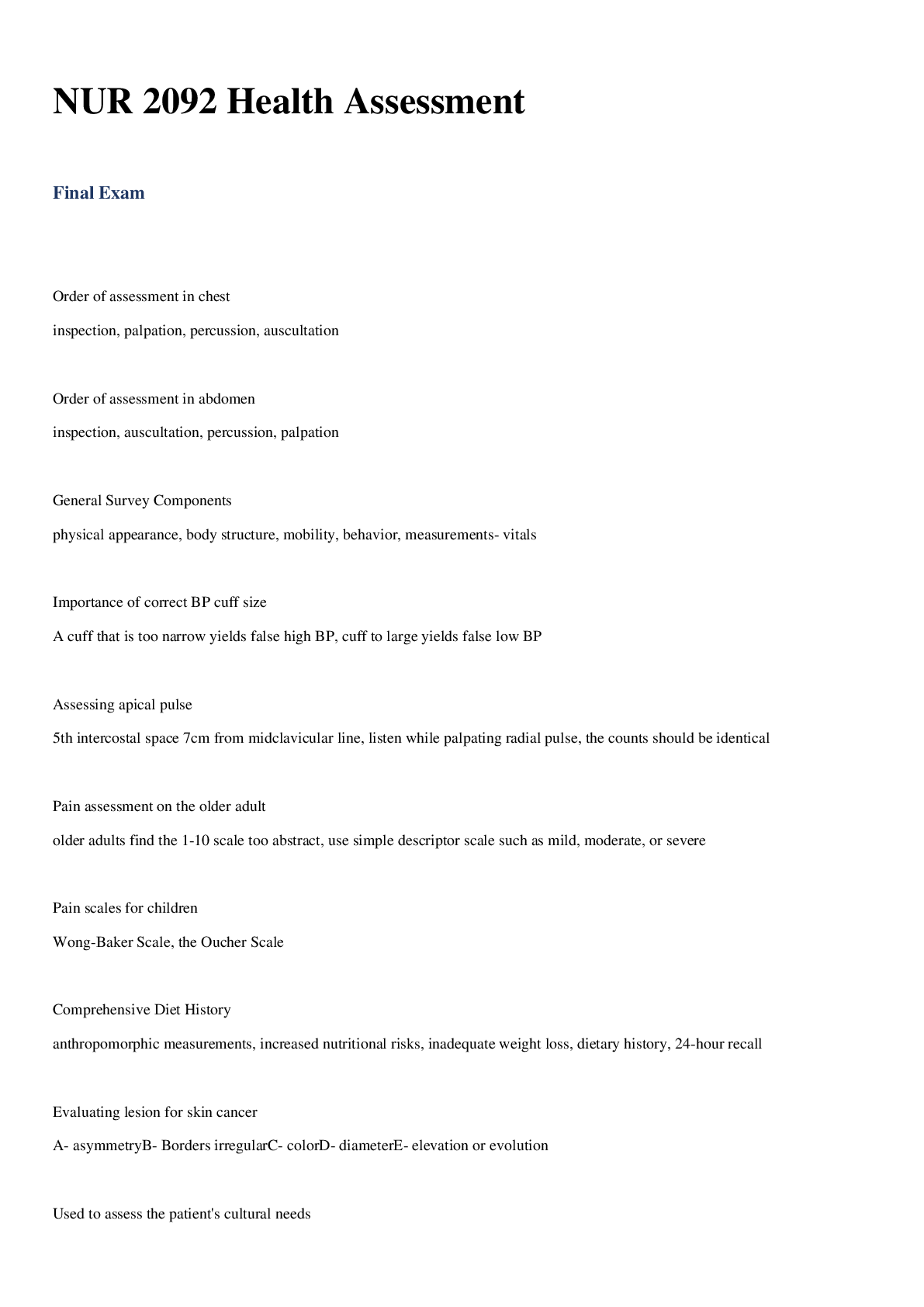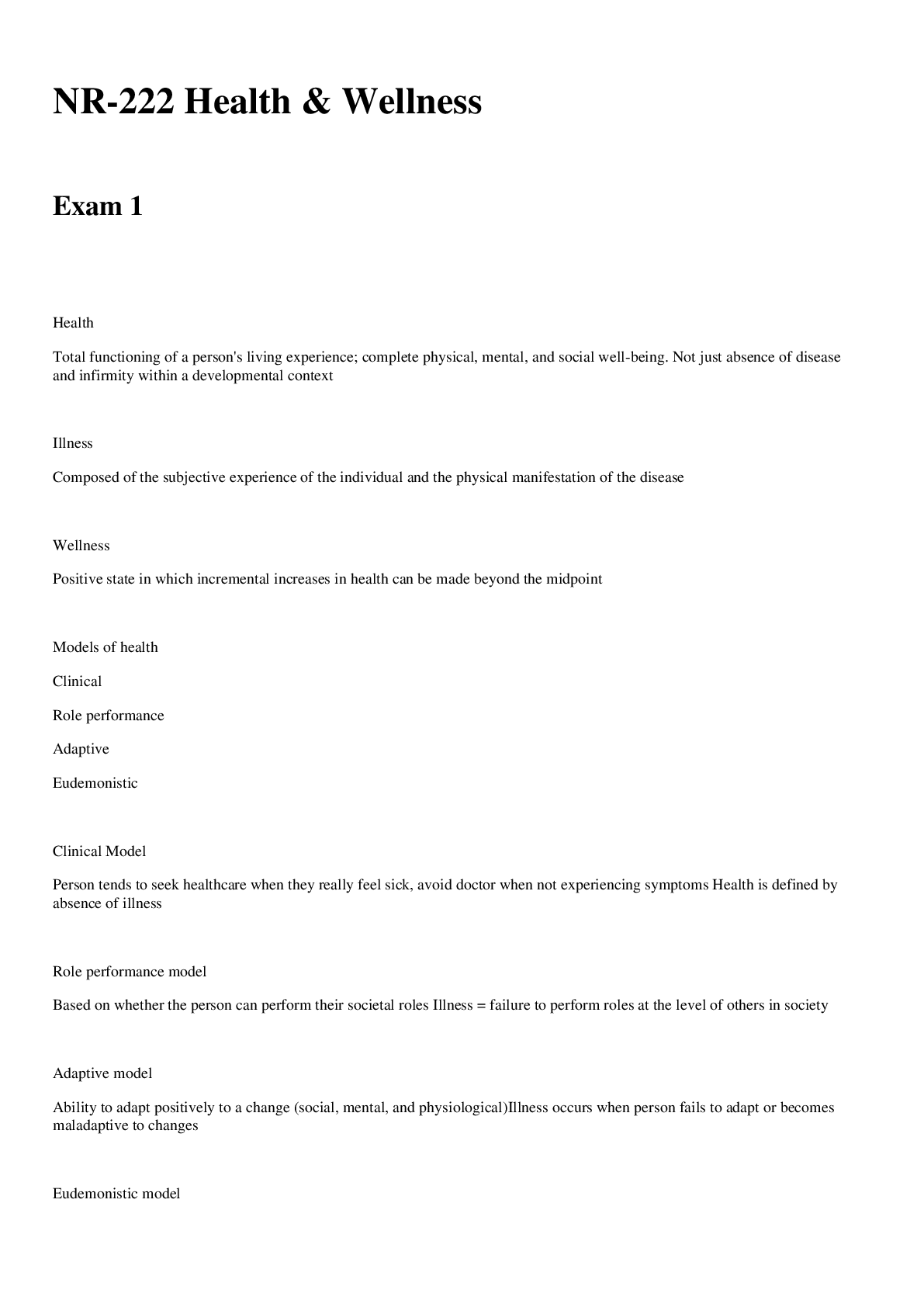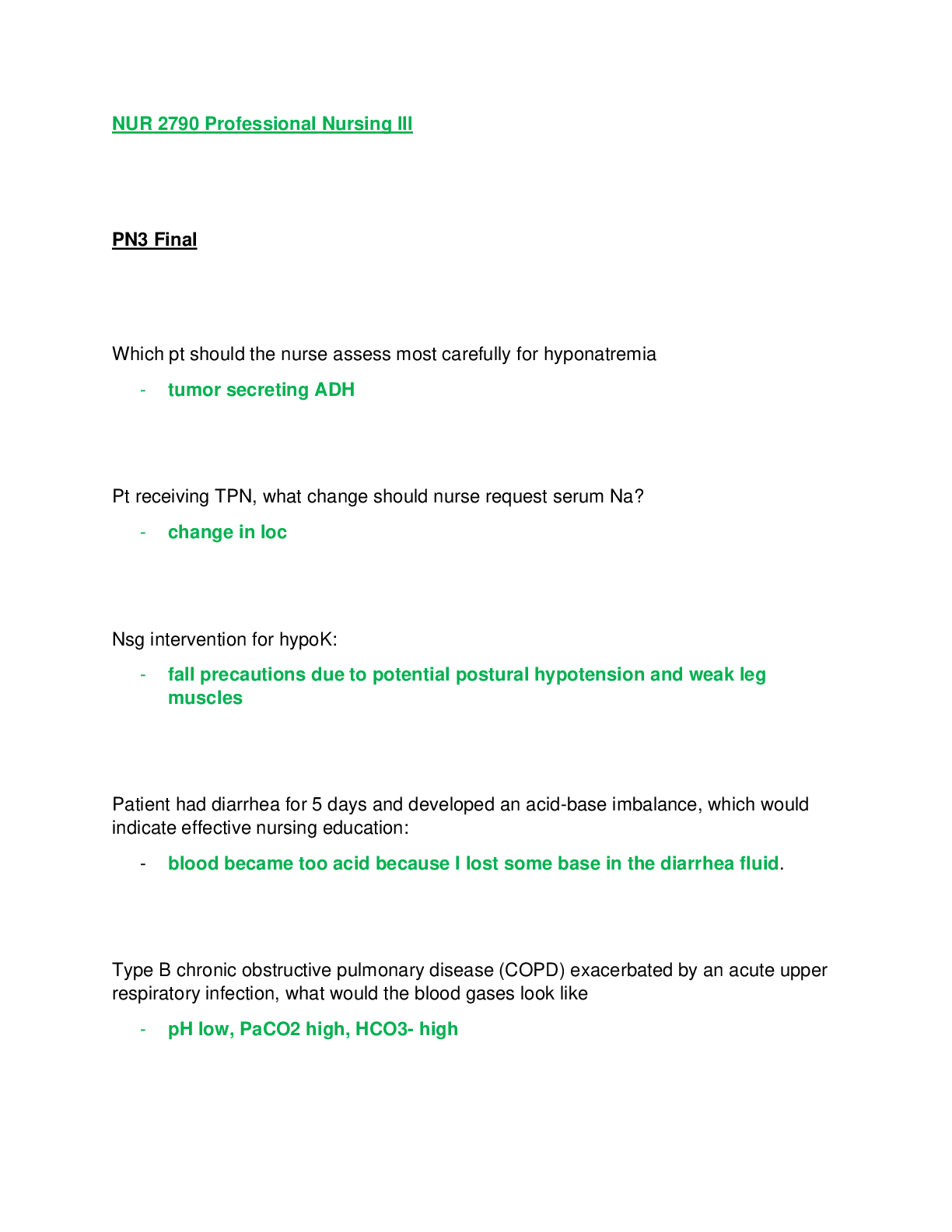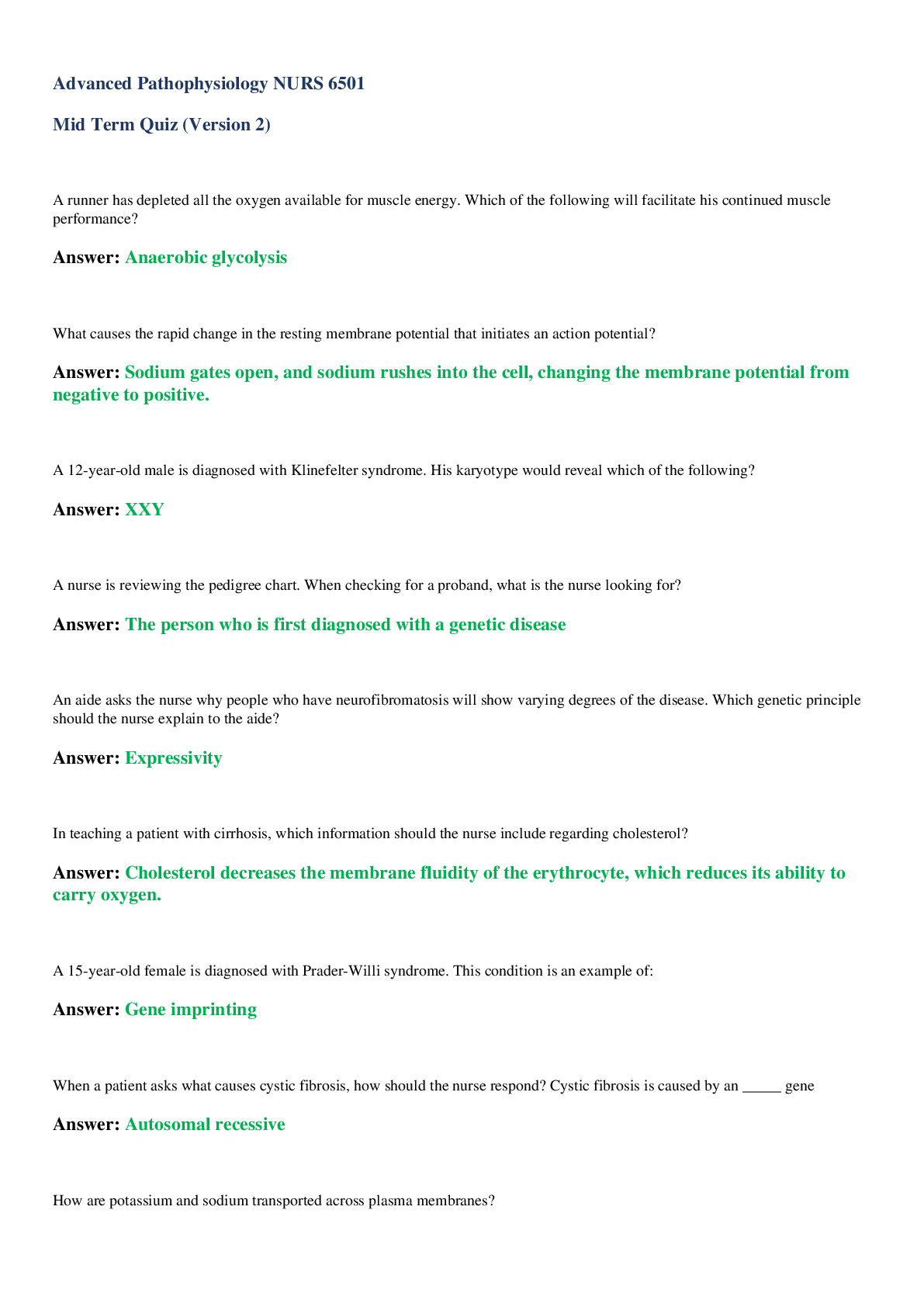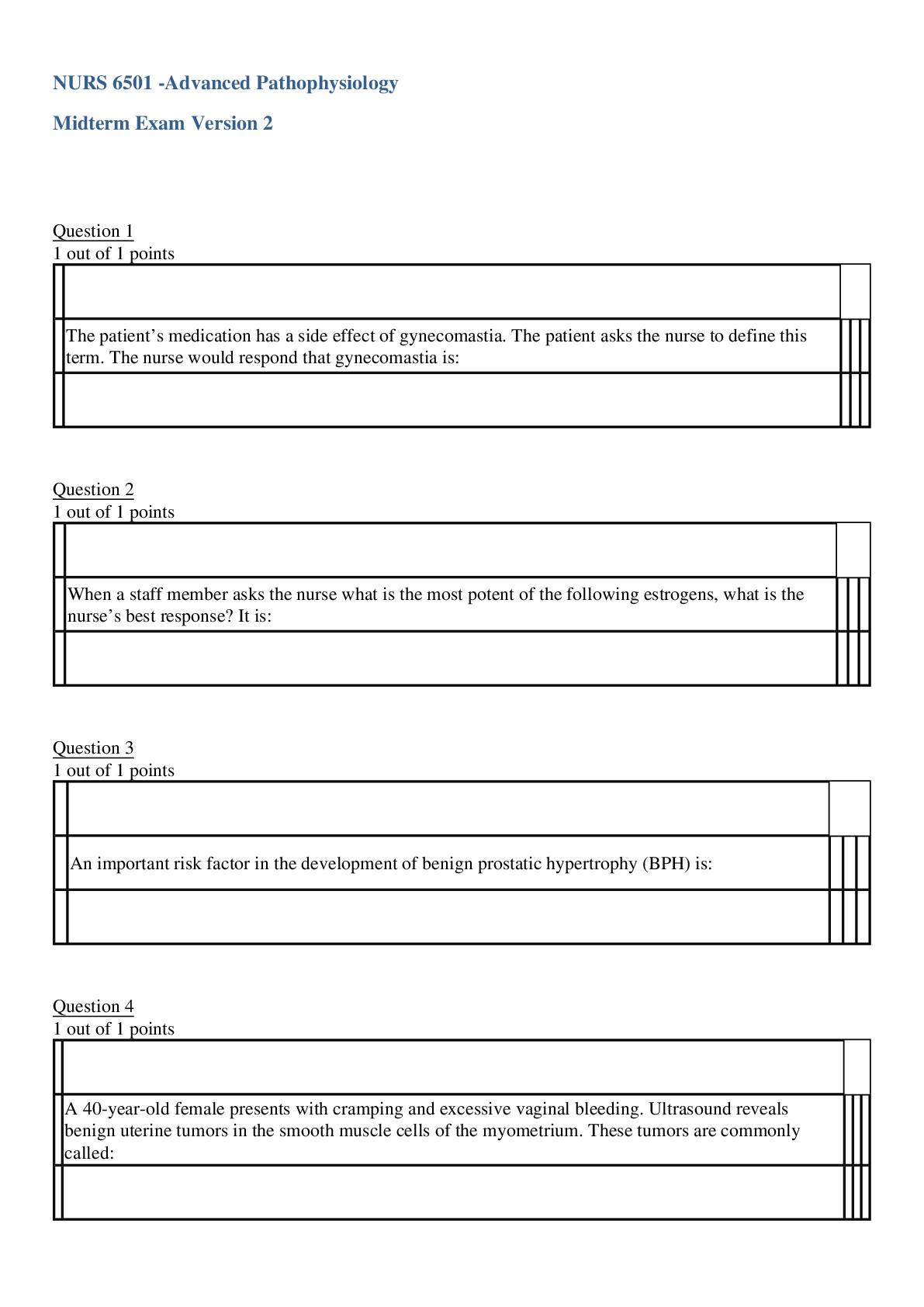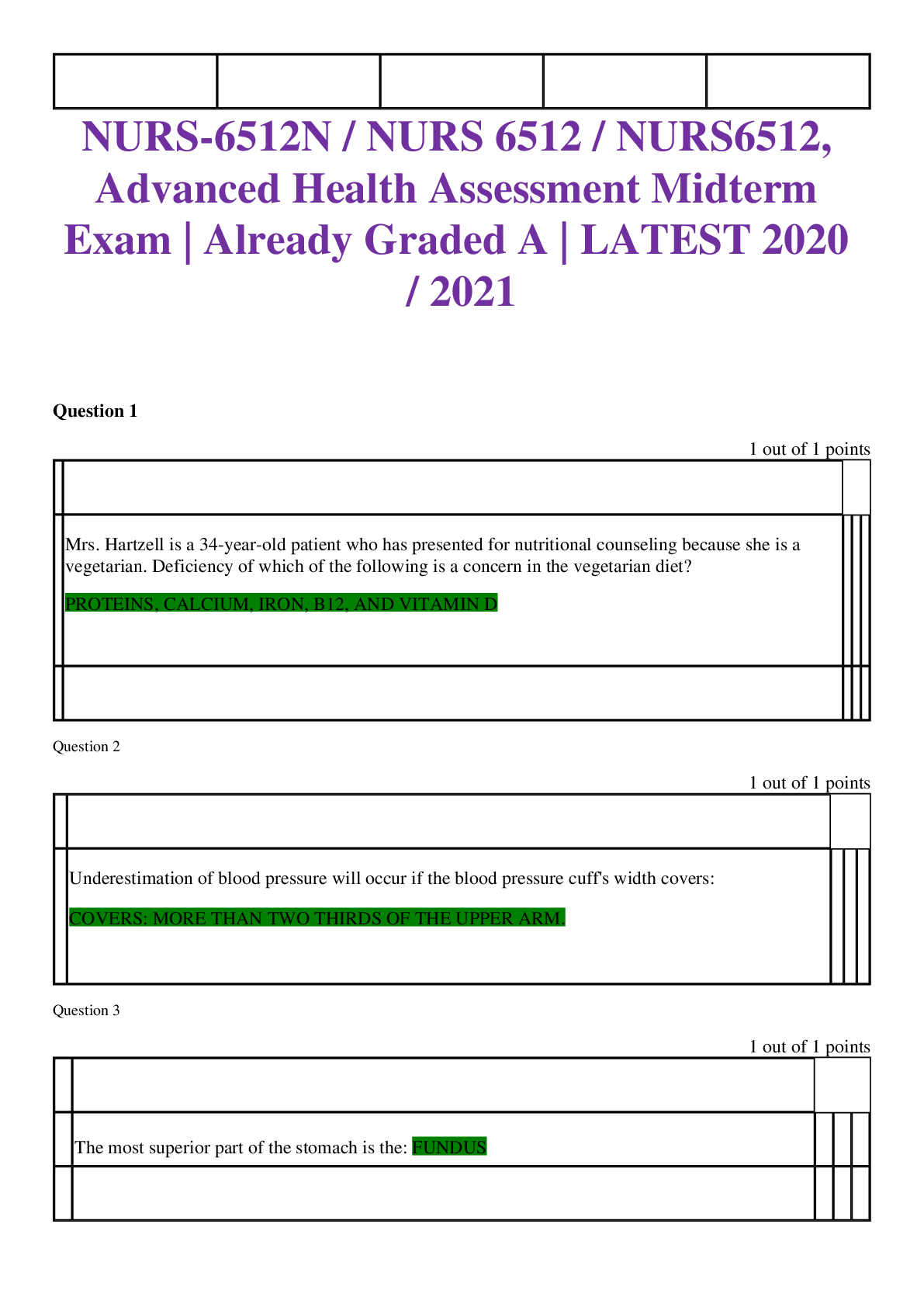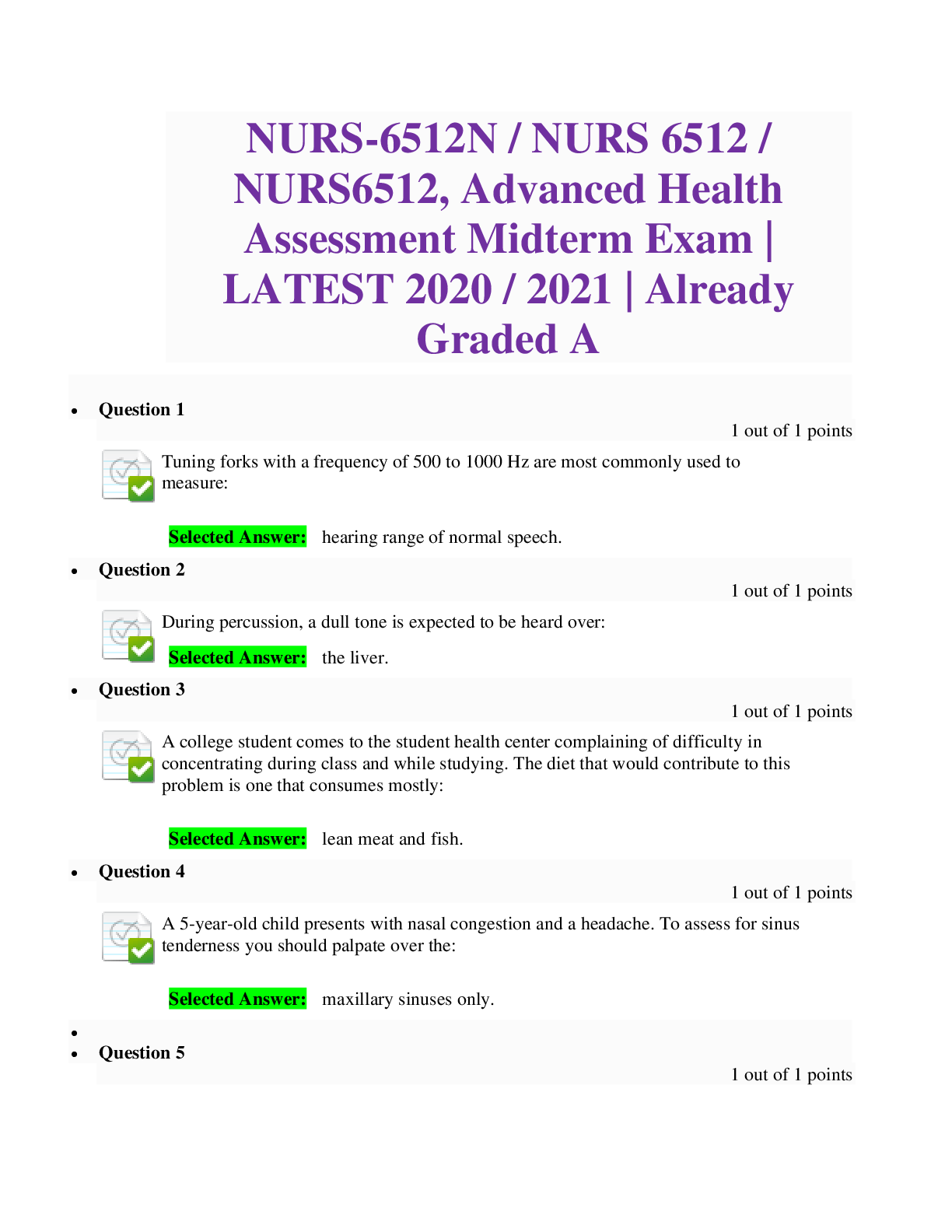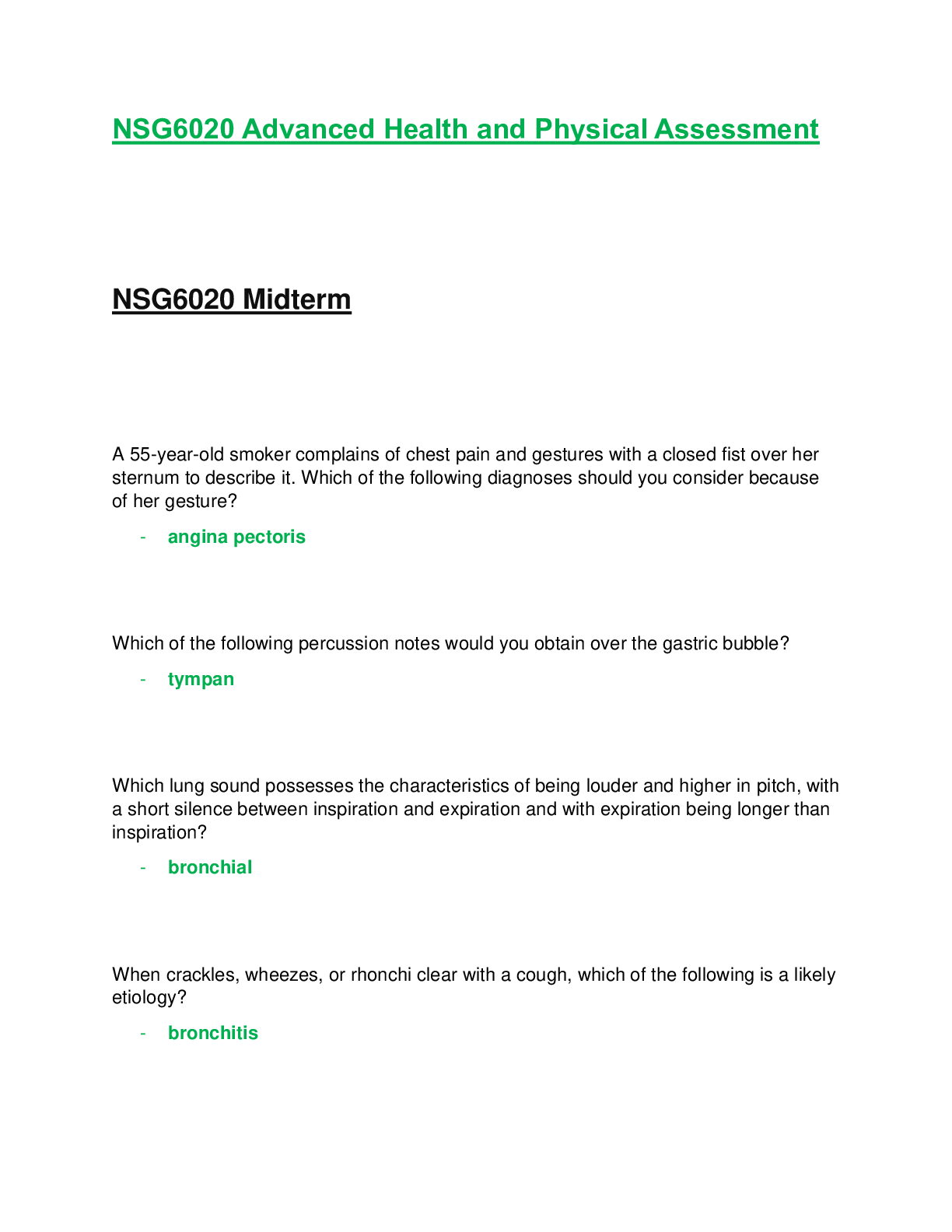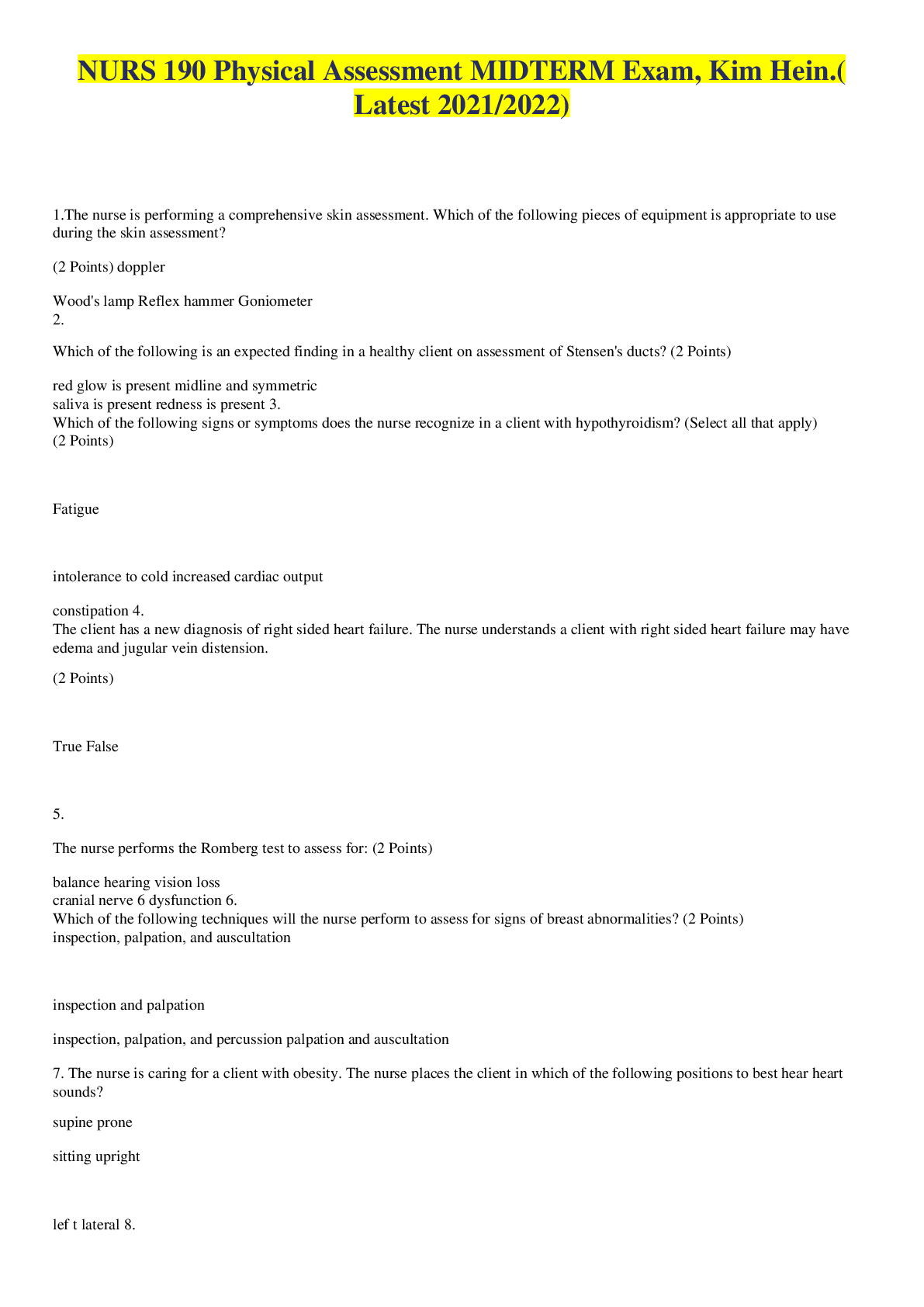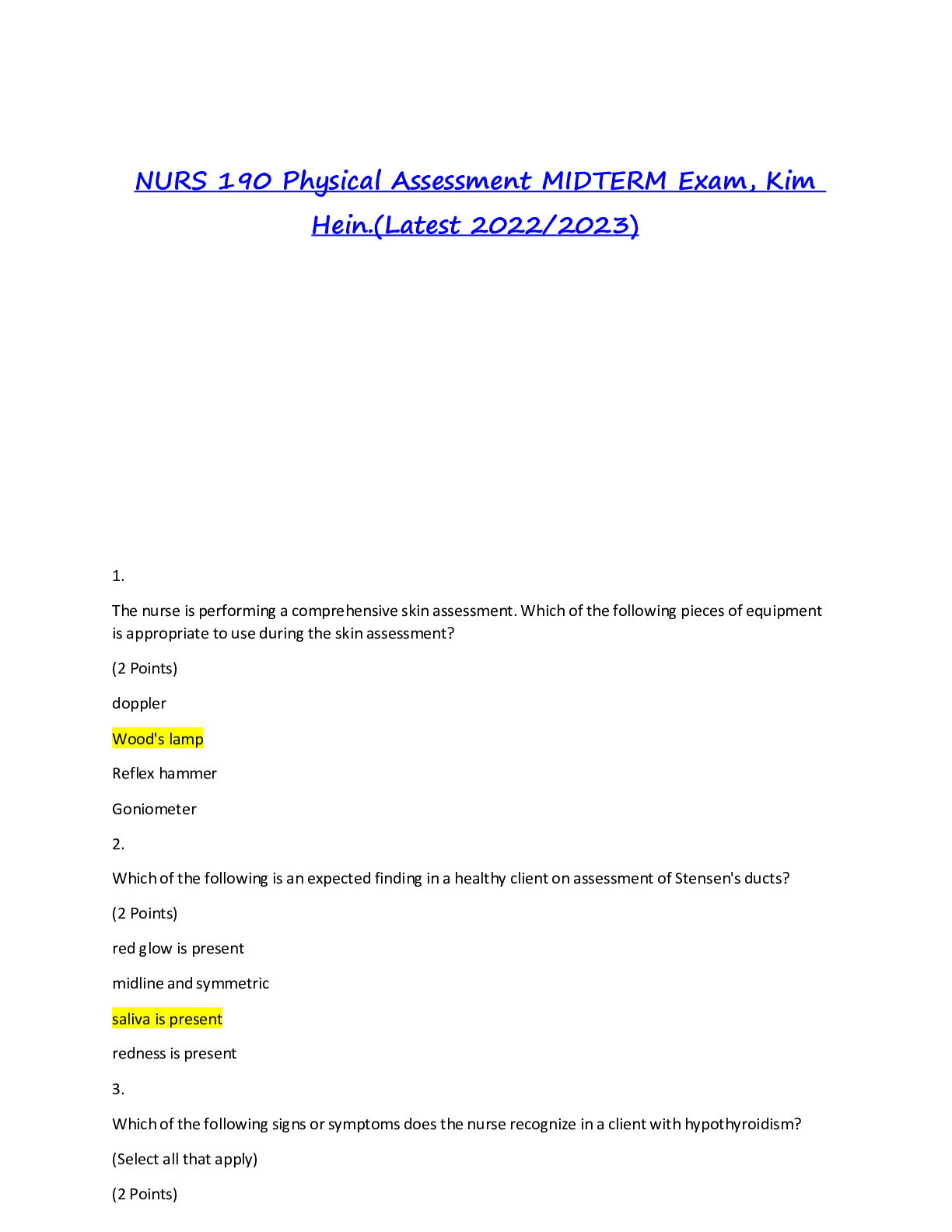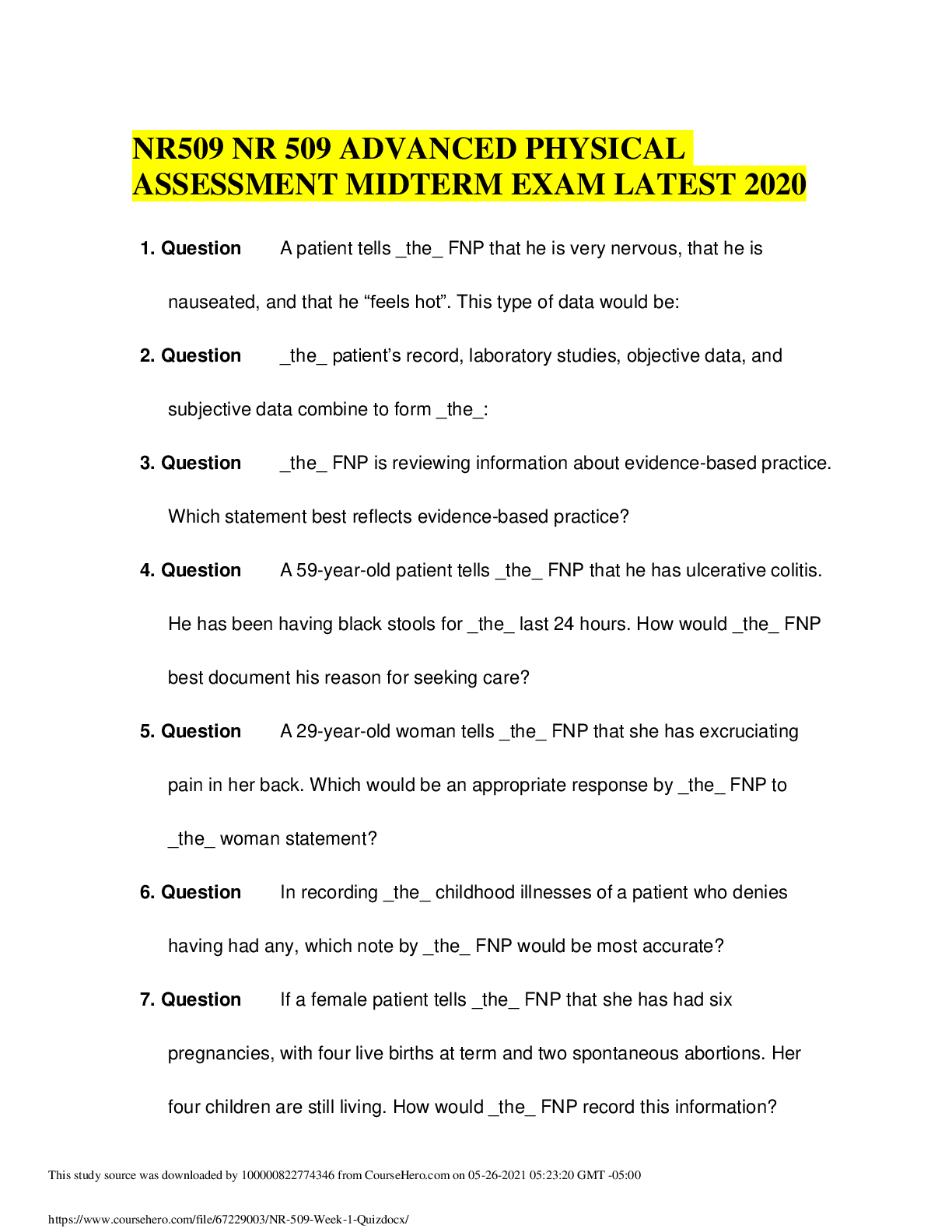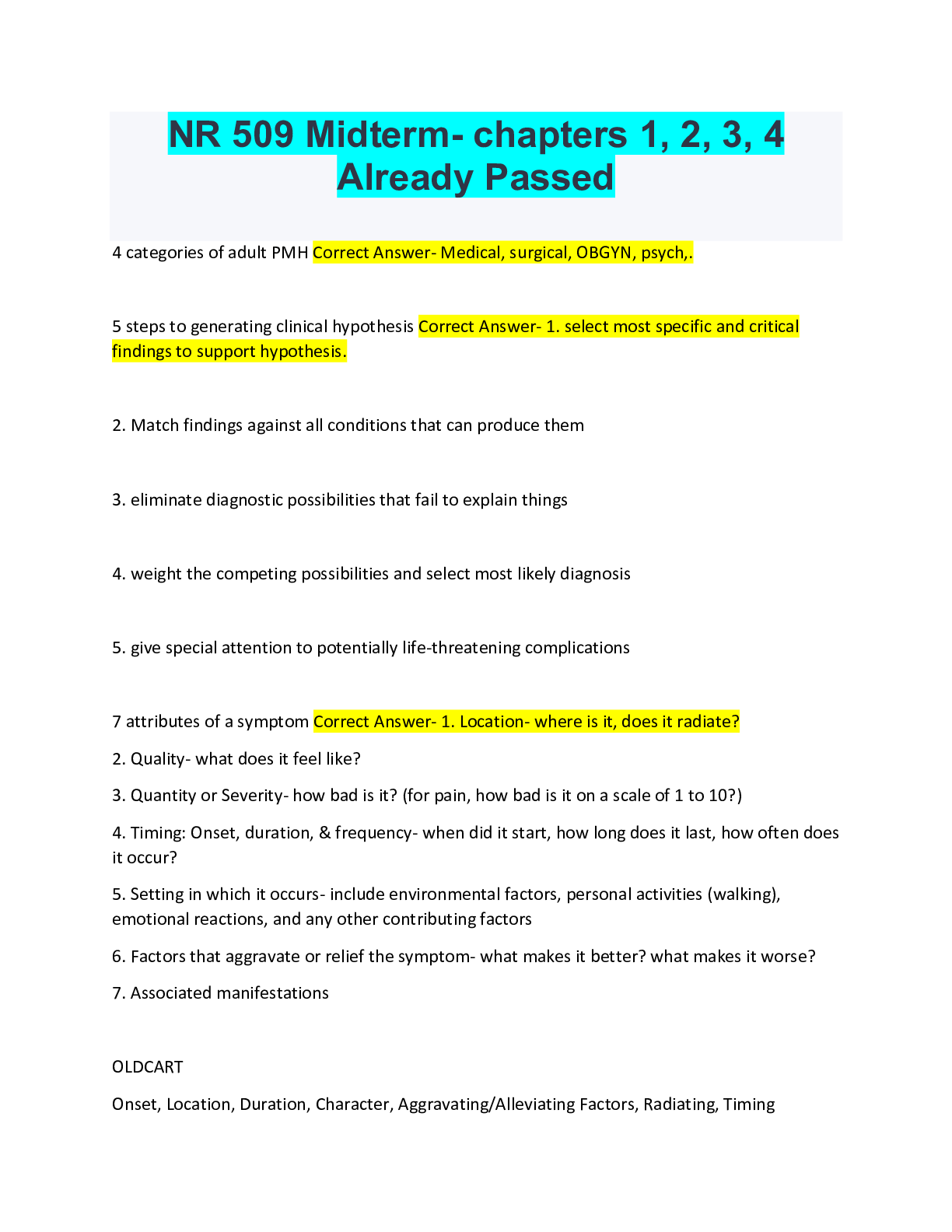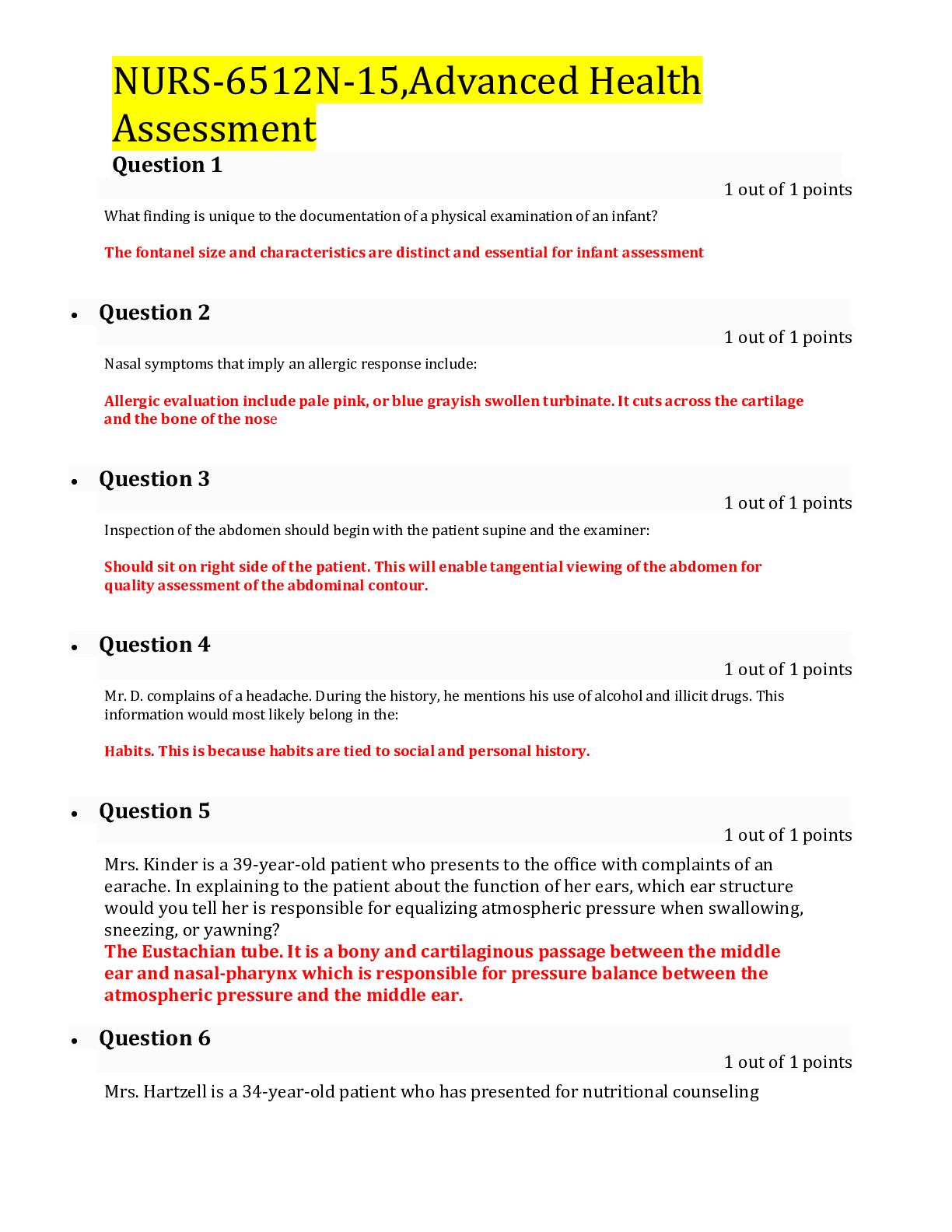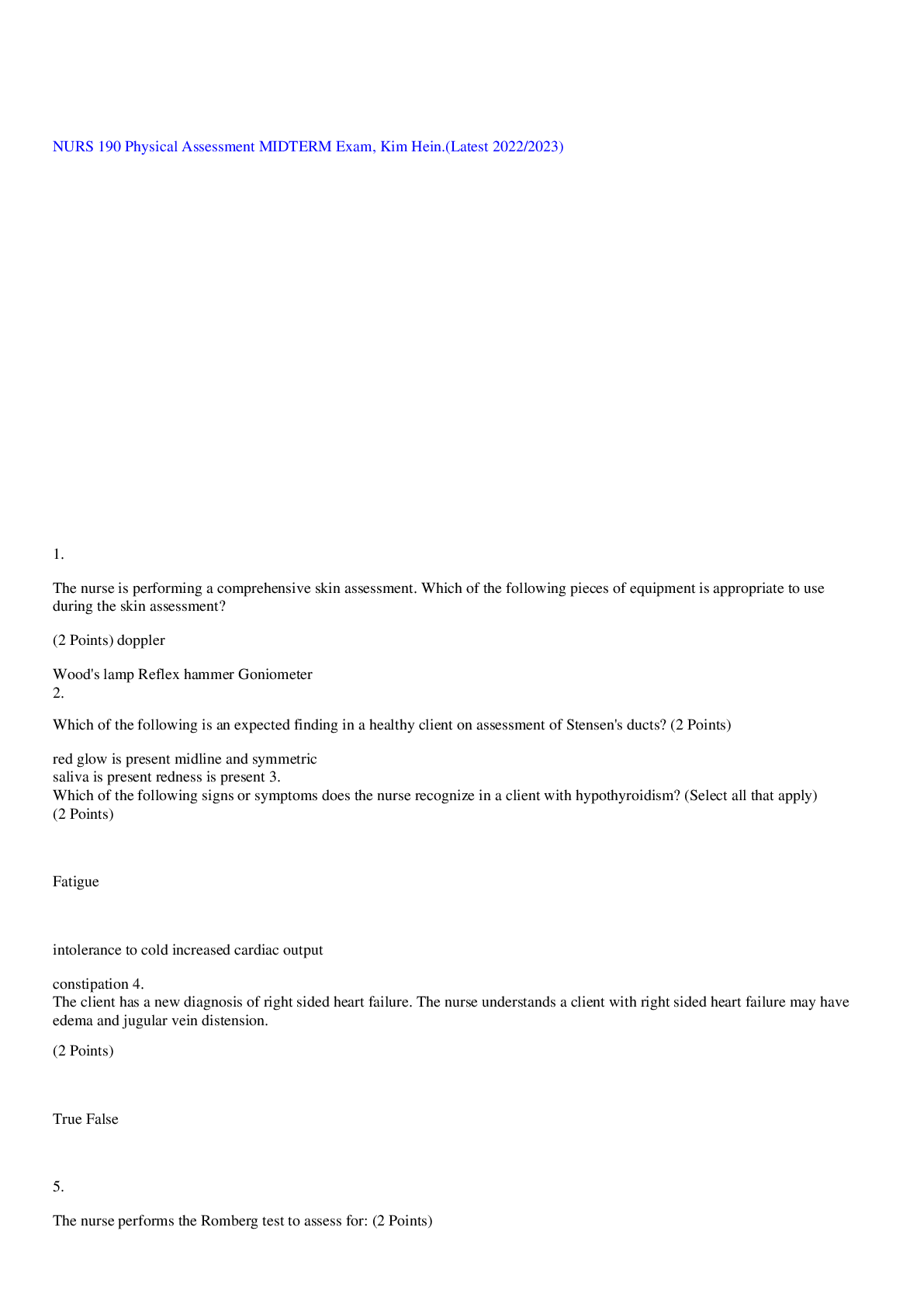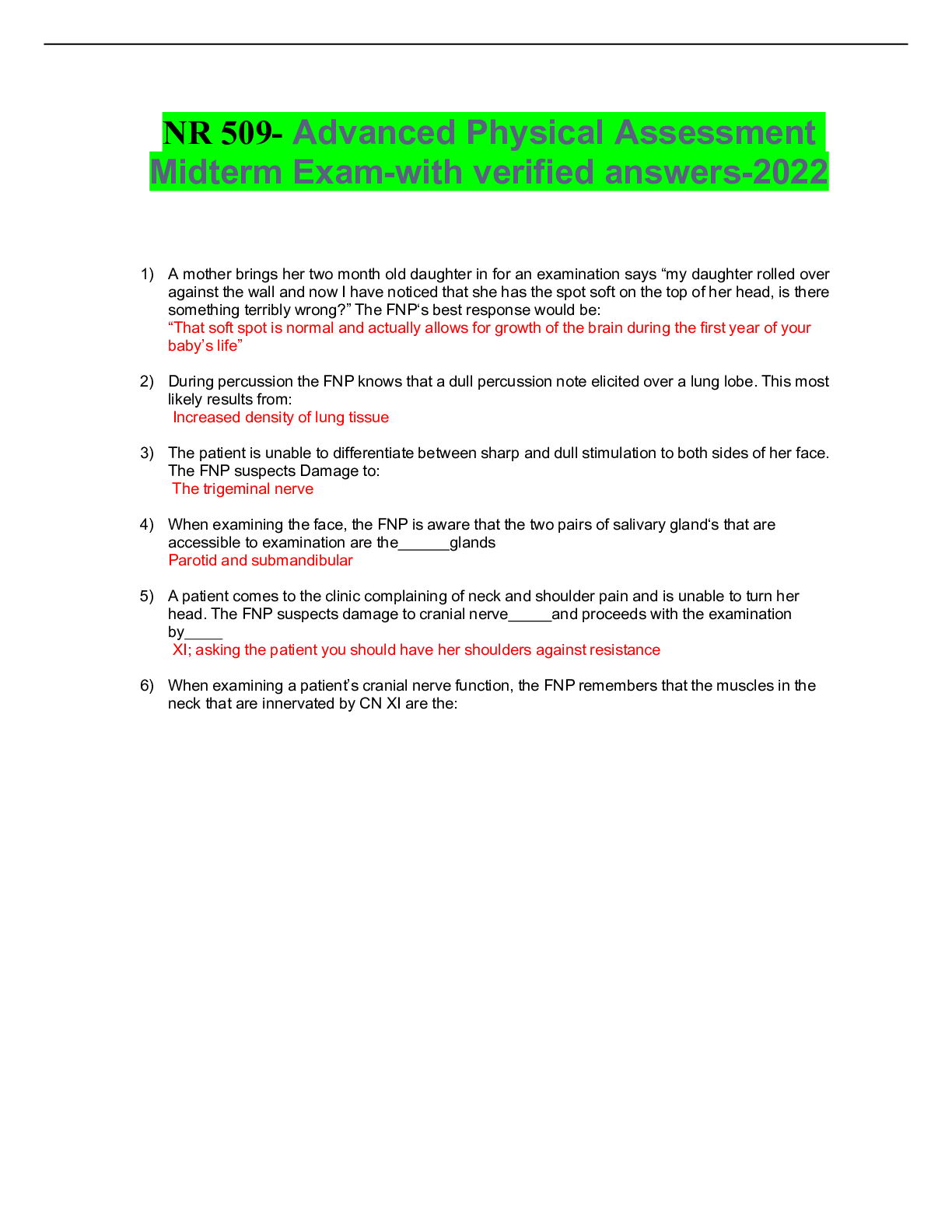*NURSING > EXAM > NR509 / NR-509: Advanced Physical Assessment Midterm Exam (Latest,2020) Chamberlain (All)
NR509 / NR-509: Advanced Physical Assessment Midterm Exam (Latest,2020) Chamberlain
Document Content and Description Below
NR-509 Advanced Physical Assessment Midterm Exam 1. During an examination, the patient has just successfully completed the finger to nose and rapid alternating movements test and is able to run ... each heel down the opposite shin. The FNP would conclude that the patient's______ function is intact - 2. During an oral assessment of a 30-year-old African-American patient, the FNP notices bluish lips and a dark line along the gingival margin. What would the FNP do in response to these findings - 3. During percussion the FNP knows that a dull percussion note elicited over a lung lobe. This most likely results from: - 4. During the history a patient tells the FNP that "it feels like the room is spinning around me". The FNP would document this as: - 5. During the neurological assessment of a healthy 35-year-old patient the FNP asks him to relax his muscles completely. The FNP then moves each extremity through full range of motion. Which of these results would the FNP expect to find? - 6. A five-year-old child is in the clinic for checkup. The FNP would expect him to: - 7. The FNP has completed an examination of a patient’s extra-ocular muscles. When documenting the findings, the FNP should document the assessment of which cranial nerves? - 8. The FNP is aware that the four areas in the body were lymph nodes accessible are the: - 9. The FNP is doing an assessment on a 21-year-old patient and notices that his nasal mucosa appears pale gray and swollen. What would be the most appropriate question to ask the patient? - 10. The FNP is doing an assessment on a 29-year-old woman who visits the clinic complaining of always dropping things and falling down. While testing rapid alternating movements the FNP notices that the woman is unable to pat both her knees. Her response is very slow and she misses frequently. What should the FNP suspect? - 11. The FNP is incorporating a person's spiritual values into the health history. Which of these questions illustrates the community portion of the FICA questions? - 12. The FNP is obtaining a history for a 30-year-old male patient and is concerned about health promotion activities. Which of these questions would be appropriate to use to assess health promotion activities for this patient? - 13. The FNP is palpating the sinus areas. If the findings are normal, then the patient should report which sensation? - 14. The FNP is performing a neurological assessment on a 41-year-old woman with a history of diabetes. When testing her ability to feel the vibrations of a tuning fork the FNP notices that the patient is unable to feel vibrations on the great toe or ankle bilaterally, but she is able to feel vibrations on both patellae. Given this information what would the FNP suspect? - 15. The FNP is performing a review of symptoms. Which of these questions are appropriate as health promotion questions to ask during this time? - 16. The FNP is performing a vision examination. What chart is most widely used for visual examination? - 17. The FNP is performing the diagnostic positions test. Normal findings would be which of these results? - 18. The FNP is preparing to assess the visual acuity of a 16-year-old patient. How should the FNP proceed? - 19. The FNP is preparing to complete a health assessment on a 1-year-old girl whose parents have brought her to the clinic. Which instruction would be appropriate for the parents before the interview begins? - 20. The FNP is reviewing information about evidence-based practice. Which statement best reflects evidence-based practice? - E 21. The FNP is reviewing the technique of palpating for tactile fremitus with a new graduate. Which statement by the graduate FNP reflects a correct understanding of tactile fremitus? - 22. The FNP is teaching a class on osteoporosis prevention to a group of post-menopausal women. A participant shows that she needs more instruction when she states I will: - 23. The FNP is teaching a class on osteoporosis prevention to a group of postmenopausal women which of these actions is the best way to prevent or delay bone loss in this group? - 24. The FNP is testing the function of cranial nerve XI. Which of these bests describes the response the FNP should expect if the nerve is intact? - 25. The FNP notices that the patient's submental lymph nodes are enlarged. In an effort to identify the cause of the node enlargement, the FNP would assess the patient's: - 26. The FNP student is reviewing physical assessment findings of the HEENT system associated with pregnancy. Which statement by the graduate FNP reflects a correct understanding of expected HEENT changes associated with pregnancy? - 27. The FNP suspect that a patient has carpal tunnel syndrome and wants to perform the Phalen’s test. To perform this task the FNP should instruct the patient to: - 28. If a female patient tells the FNP that she has had six pregnancies, with four live births at term and two spontaneous abortions. Her four children are still living. How would the FNP record this information? - 29. In obtaining a history on a 74-year-old patient the FNP notes that he drinks alcohol daily and that he has noticed a tremor in his hands that affects his ability to hold thing. With this information what should the FNP's response be? - 30. In recording the childhood illnesses of a patient who denies having had any, which note by the FNP would be most accurate? - 31. A mother brings her two-month-old daughter in for an examination says "my daughter rolled over against the wall and now I have noticed that she has the spot soft on the top of her head, is there something terribly wrong?" The FNP's best response would be: - 32. A patient comes to the clinic complaining of neck and shoulder pain and is unable to turn her head. The FNP suspects damage to cranial nerve ____ and proceeds with the examination by____ - 33. A patient has been diagnosed with osteoporosis and asked the FNP "what is osteoporosis?" The FNP explains to the patient that osteoporosis is defined as: - 34. A patient is able to flex his right arm forward without difficulty or pain but is unable to abduct his arm because of pain and muscle spasms. The FNP should suspect: - 35. A patient is complaining of pain in his joints that is worse in the morning, is better after he has moved around for a while, and then gets worse again if he sits for long periods of time. The FNP should assess for other signs of what problem? - 36. The patient is unable to differentiate between sharp and dull stimulation to both sides of her face. The FNP suspects Damage to: - 37. A patient is unable to read even the largest letters on the Snellen chart. The FNP should take which action next - 38. A patient is unable to shrug her shoulders against the FNP's resistant hands. What cranial nerve is involved with successful shoulder shrugging? - 39. A patient says that she has recently noticed a lump in the front of her neck below her "Adams apple" that seems to be getting bigger. During the assessment, the finding that leaves the FNP to suspect that this may not be a cancerous thyroid nodule is that the lump: - 40. The patient's laboratory data reveal an elevated thyroxine level. The FNP would proceed with an examination of the _____ gland - 41. The patient's record, laboratory studies, objective data, and subjective data combine to form the: - 42. Patient states, "I can hear a crunching or grating sound when I kneel". She also states "that it is very difficult to get out of bed in the morning because of stiffness and pain in my joints". The FNP should assess for signs of what problem? - 43. A patient's uvula rises midline when she says "ahh" and she has a positive gag reflex. The FNP has just tested which cranial nerves? - 44. A patient's vision is recorded as 20/30 when the Snellen eyechart is used. The FNP interprets these results to indicate that: - 45. A patient's vision is reported as 20/80 in each eye. The FNP interprets this finding to mean that - 46. A patient tells the FNP that he is very nervous, that he is nauseated, and that he "feels hot". This type of data would be: - 47. A professional tennis player comes into the clinic complaining of a sore elbow. The FNP will assess for tenderness at the: - 48. A teenage girl has arrived complaining of pain in her left wrist. She was playing basketball when she fell and landed on her left hand. The FNP examined her hand and will expect a fracture if the girl complains: - 49. When examining a patient's cranial nerve function, the FNP remembers that the muscles in the neck that are innervated by CN XI are the: - 50. When examining the face, the FNP is aware that the two pairs of salivary glands that are accessible to examination are the _____ glands - 51. When performing the corneal light reflex assessment, the FNP notes that the light is reflected at 2 o'clock in each eye. The FNP should - 52. When taking the history on a patient with a seizure disorder the FNP assesses whether the patient has an aura. Which of these would be the best question for obtaining this information? - 53. When the FNP asks a 68-year-old patient to stand with feet together and arms at his side with his eyes closed he starts to sway and moves his feet farther apart. The FNP would document this finding as: - 54. When the FNP performs the confrontation test the FNP has assessed - 55. Which of these is included in the assessment of general appearance? - 56. Which of these statements is true regarding recording of data from the history and physical examination? - 57. Which of these statements is true regarding the complete physical assessment? - 58. Which of these statements represents subjective data the FNP obtained from the patient regarding the patient’s skin? - 59. Which statement indicates that the FNP understands the pain experienced by an elderly person? - 60. While obtaining a history of a 3-month-old infant from the mother the FNP asks about the infant’s ability to suck and grass the mother’s finger. What is the FNP assessing? - 61. A woman who is 8 months pregnant comments that she has noticed a change in posture and is having lower back pain. The FNP tells her that during pregnancy women have a posture shift to compensate for the enlarging fetus. This shift and posture is known as: - 62. A 29-year-old woman tells the FNP that she has excruciating pain in her back. Which would be an appropriate response by the FNP to the woman's statement? - 63. A 50-year-old woman is in a clinic for weakness in her left arm and leg that she noticed for the past week. The FNP should perform which type of neurologic examination? - 64. A 52-year-old patient describes the presence of occasional floaters or spots moving in front of his eyes. The FNP should know that floaters are usually not significant and are caused by: - 65. A 59-year-old patient tells the FNP that he has ulcerative colitis. He has been having black stools for the last 24 hours. How would the FNP best document his reason for seeking care? - 66. A 60-year-old man is at the clinic for an examination. The FNP suspects that he has ptosis of one eye. How should the FNP check for this? - 67. An 85-year-old patient comments during his annual physical that "he seems to be getting shorter as he ages". The FNP should explain that decrease height occurs with aging because: - 68. An 80-year-old woman is visiting the clinic for a checkup. She states "I can't walk as much as I used to". The FNP is observing from motor dysfunction in her hip and should have her: - 69. The assessment of a 60-year-old patient has taken longer than anticipated. In testing his pain perception, the FNP decides to complete the test as quickly as possible. When the FNP applies the sharp point of a pin on his arm several times he is only able to identify these as one very sharp prick. What would be the most accurate explanation for this? - 70. During a complete health assessment, how would the FNP test the patients hearing? - 71. During a history of a 78-year-old man his wife states that "he occasionally has problems with short-term memory loss and confusion. He can't even remember how to button his shirt". In doing the assessment of his sensory system which action of the FNP's is most appropriate? - at this time 72. During an assessment of a 20-year-old patient with a three-day history of nausea and vomiting the FNP notices dry mucous and deep vertical fissures on the tongue. These findings are reflective of: - 73. During an assessment of the cranial nerves the FNP finds the following asymmetry when the patient smiles or frowns, uneven lifting of eyebrows, sagging of lower eyelids, and escape of air when the FNP presses against the right path cheek. This would indicate dysfunction of which of these cranial nerves? - 74. During an assessment of the sclera of an African-American patient, the FNP would consider which of these an expected finding? - 75. During an examination the FNP notices that a patient is unable to stick out his tongue. Which cranial nerve is involved with successful performance of this action? - [Show More]
Last updated: 11 months ago
Preview 1 out of 9 pages

Reviews( 2 )
Document information
Connected school, study & course
About the document
Uploaded On
Nov 15, 2020
Number of pages
9
Written in
Additional information
This document has been written for:
Uploaded
Nov 15, 2020
Downloads
5
Views
137


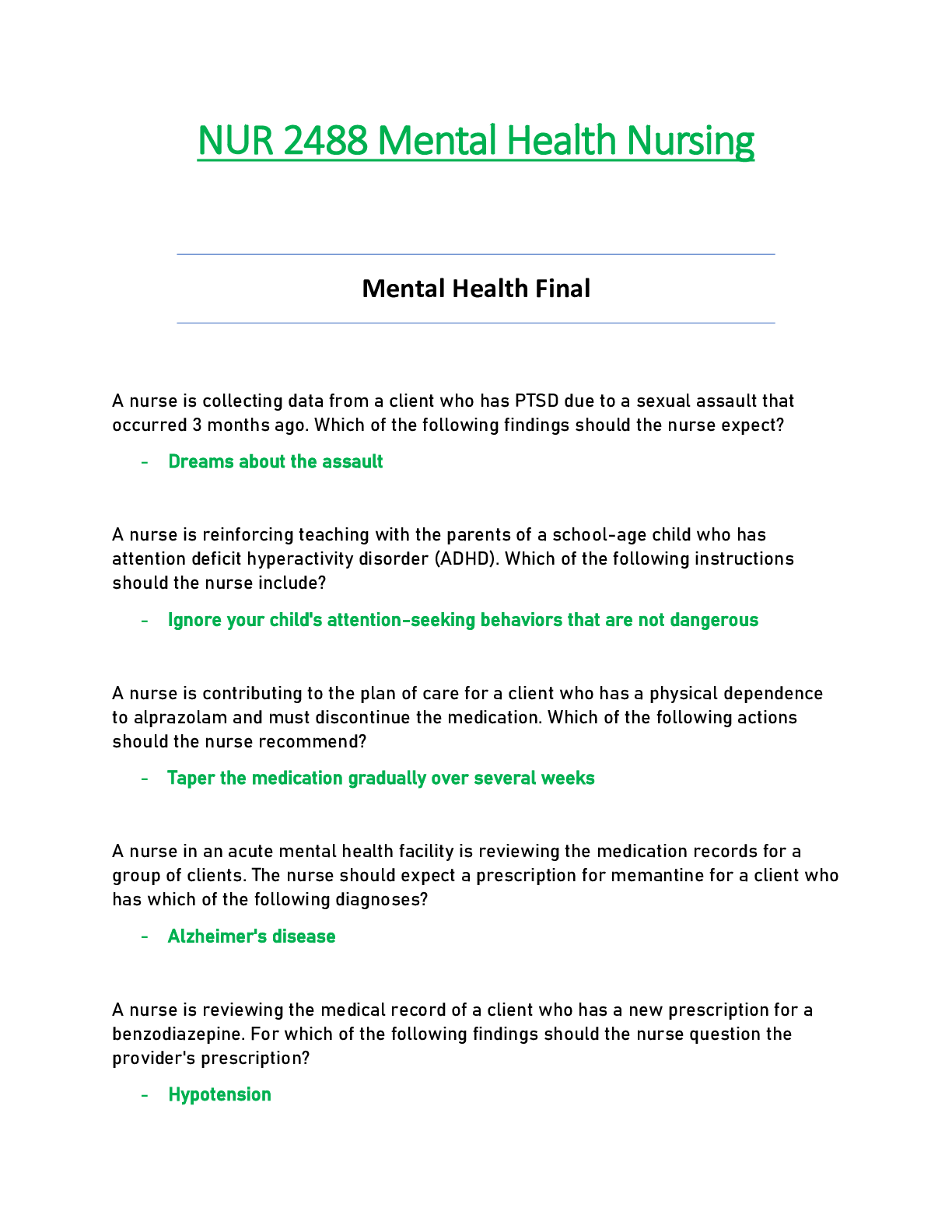
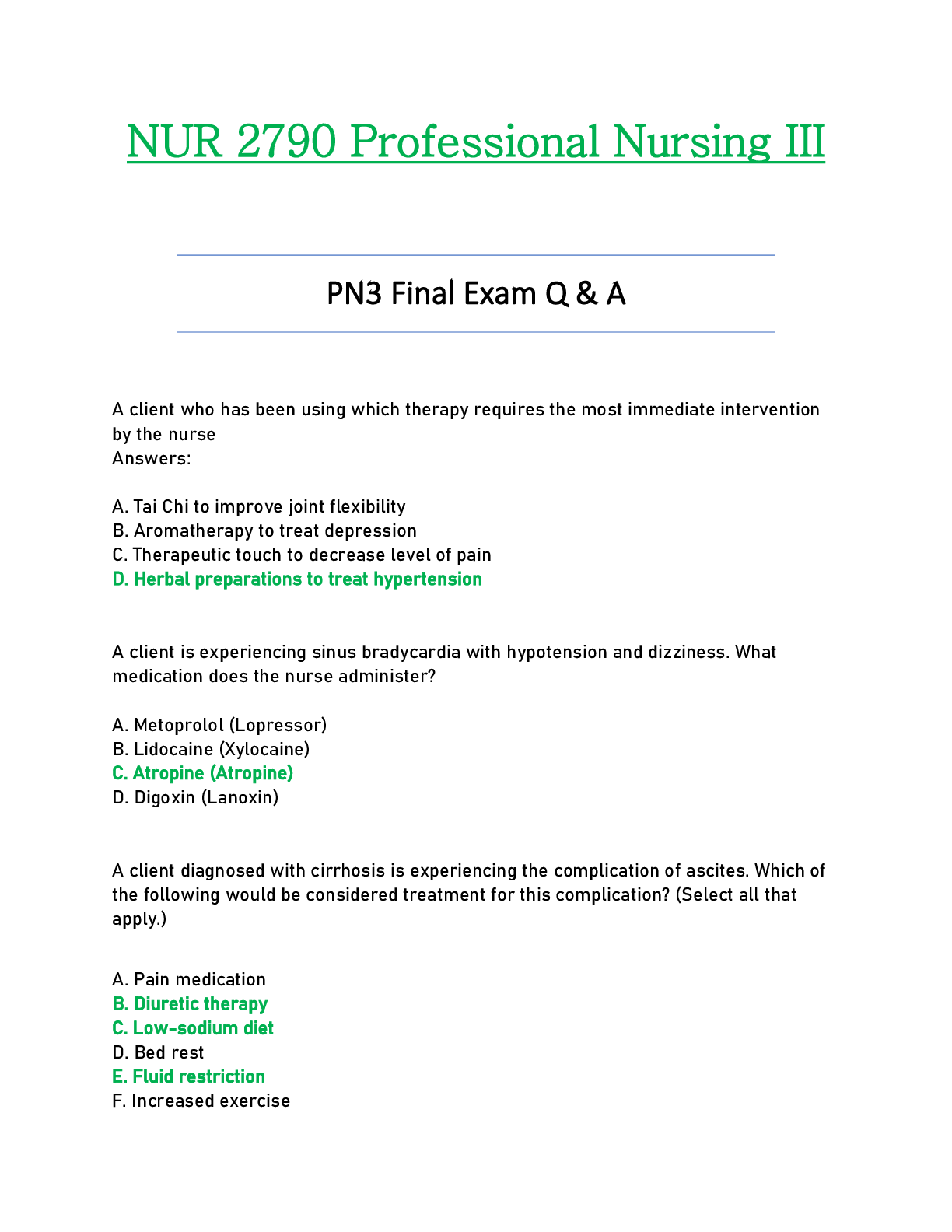
.png)
